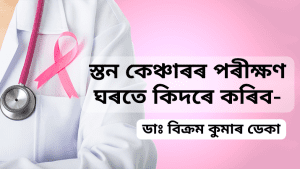The mega Hollywood star opted for mastectomy (a surgical procedure to remove one or both breasts) after finding out that she has a high probability of developing breast cancer. Was this extreme step necessary even though she didn’t develop the disease? Let’s find out.

Breast cancer is one of the most common cancers in the world – about 1 in 4 cancer cases in women is breast cancer, and about 1 in 8 women will develop breast cancer in their lifetime. It is also the highest recorded cancer type among women in India as well as in Assam.
Jolie’s mother & aunt both had cancer, which ultimately became the cause of their deaths. Even her grandmother died of ovarian cancer, a type of cancer that can originate due to the same gene mutation that causes breast cancer.
Such events among her close relatives were already an indication that she may have a defect in either BRCA1 or BRCA2, the genes whose mutation results in breast and/or ovarian cancer. However, only 10-15% of breast cancer cases are hereditary despite having about 1.5-3x more risk of developing it if a woman’s sister or mother has/had the disease. Other various factors such as hormonal, dietary & environmental have a larger influence on the risk.
So is surgical intervention (Prophylactic mastectomy), the only preventive measure that is available for women with a high risk of this cancer? Yes & No.
No, because women with high risk can still choose to consult an oncologist & work on factors that reduce the risk, however (and this is why we say “Yes”), these measures may not be enough to prevent it entirely throughout one’s life. The surgical procedure in this case is more effective and reduces the risk significantly.
Ms. Jolie’s gene testing results showed that she was BRCA1 positive with an 87% risk of developing breast cancer & 50% risk of developing ovarian cancer. After the double mastectomy, her chances of breast cancer dropped to 5%.
In conclusion, bold? Yes, an overreaction? Definitely no. She took a decision that she was most comfortable with, to prevent developing breast cancer, and that is the message she conveys in her 2013 op-ed published in The New York Times. The op-ed is a document of her journey leading to the decision, it encourages women to be proactive & seek out medical information to make an informed choice.
Furthermore, despite how common it is in the world, breast cancer is not one of the most common causes of cancer deaths. It has a good prognosis if diagnosed early. Screening tests such as gene testing, mammogram, ultrasound, MRI or even biopsy may be recommended by an oncologist to help determine the development of the disease & suggest the most suitable preventive/treatment options available for the woman.



